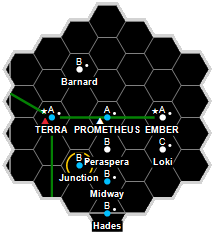Reynard
Emperor Mongoose
Traveller's view of space travel colored by the 3I universe has the norm and standard of starcraft at that midpoint of TL 12 with jump 3. Many iconic ships follow this pattern. Even Milieu 0 starts with the Sylea Federation not back to square zero having to reinvent jump and rediscover the universe but every other major race (except the Aslan) had that momentous event when their first Jump 1 ship disappeared into Jumpspace to return successfully with the news there's a bigger place beyond their solar boundary. This can apply to worlds crawling out of the Long Night or any race in non-3I universes. However, Jump 1 would be their Wall until they progressed to a technological level 11 which could take from decades to centuries without outside assistance. The population of these beginning star traveling civilizations would have a far different perspective. Exploration and colonization would be a monumental undertaking even with generous Mains (worlds linked by one jump).
Probably the most common vessel in the yearly years will be the explorer, the precursor to the TL 12 Scout. This one is one particular design that are size efficient to do the most primary mission of system pathfinding. They gather as much macro information about a system for analysis as to the value for further research, economics and possible colonization but their spartan supply loads make long term and detailed exploration difficult without establishing supply depots and outposts. They sacrifice other amenities for enough fuel for two separate jumps as emergency and for systems without gas giants. Unlike the more advanced scout, these vessels carry a laboratory and a scientist for allowing more extensive evaluation in the short time they have. The pilot, astrogator and engineer will also have some cross training to assist in assessment. An air/raft is for any extraordinary attempts at planetside exploration.
TL 9 Early Explorer 100 tons MCr.35.32
Streamlined hull. No armor.
Jump 1. Maneuver 1g. TL 8 Fusion power plant (50 power), Fuel 40 (2 x Jump 1 and 4 weeks standard operation).
Small bridge. Computer/5 with Maneuver/0, Library and Jump Control/1. Sensors - Civilian.
Weapons - none.
4 x Staterooms (Pilot, Astrogator, Engineer and scientist).
Options: Fuel scoops, Fuel processors (40 tons per day), Air/raft in docking bay,10 x Probe drones, Laboratory (1 researcher), Workshop.
Cargo 2.6 tons.
What other ships would be carried by Jump 1 to the new frontier and how would they be shaped? What would early travel and criteria for world potentials with these crudest of space technologies? Would planet based or orbital supply bases be common in the beginning until larger more specialized vessels and greater endurance come into production?
I was going to include a TL 8 prototype explorer but Jump Control software can't be prototyped (not a component) so the first jump ship must wait for the software to catch up.
Probably the most common vessel in the yearly years will be the explorer, the precursor to the TL 12 Scout. This one is one particular design that are size efficient to do the most primary mission of system pathfinding. They gather as much macro information about a system for analysis as to the value for further research, economics and possible colonization but their spartan supply loads make long term and detailed exploration difficult without establishing supply depots and outposts. They sacrifice other amenities for enough fuel for two separate jumps as emergency and for systems without gas giants. Unlike the more advanced scout, these vessels carry a laboratory and a scientist for allowing more extensive evaluation in the short time they have. The pilot, astrogator and engineer will also have some cross training to assist in assessment. An air/raft is for any extraordinary attempts at planetside exploration.
TL 9 Early Explorer 100 tons MCr.35.32
Streamlined hull. No armor.
Jump 1. Maneuver 1g. TL 8 Fusion power plant (50 power), Fuel 40 (2 x Jump 1 and 4 weeks standard operation).
Small bridge. Computer/5 with Maneuver/0, Library and Jump Control/1. Sensors - Civilian.
Weapons - none.
4 x Staterooms (Pilot, Astrogator, Engineer and scientist).
Options: Fuel scoops, Fuel processors (40 tons per day), Air/raft in docking bay,10 x Probe drones, Laboratory (1 researcher), Workshop.
Cargo 2.6 tons.
What other ships would be carried by Jump 1 to the new frontier and how would they be shaped? What would early travel and criteria for world potentials with these crudest of space technologies? Would planet based or orbital supply bases be common in the beginning until larger more specialized vessels and greater endurance come into production?
I was going to include a TL 8 prototype explorer but Jump Control software can't be prototyped (not a component) so the first jump ship must wait for the software to catch up.

